Syntropic Farming is a nature-inspired agriculture system developed by Mr. Ernst Götsch. It aims to grow a diversity of vegetation in an area over time, while simultaneously restoring ecosystems.
Management of this system requires strategic planning based on natural succession and synchronized pruning practices.
Syntropic derives from the term Syntropy, which proposes a relationship between species in which they thrive, eventually resulting in an abundance of resources.
According to Mr. Götsch, Syntropic Farming accelerates natural succession through observation and application of knowledge.
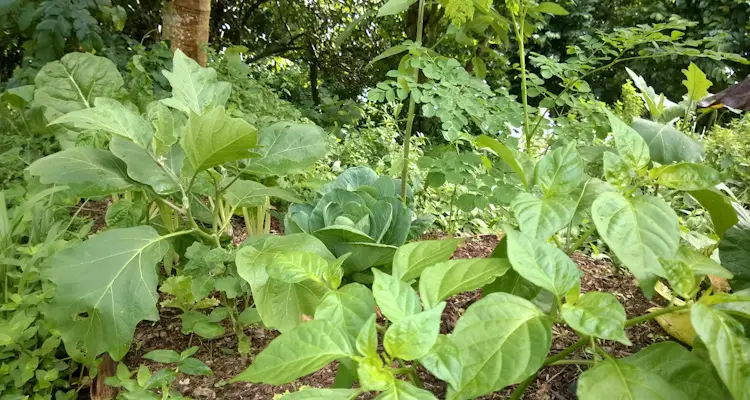
In this article, you will learn:
- 3 Core Syntropic Farming Principles
- Is Syntropic Farming Only For Tropical Regions?
- Can Syntropic Farming Be Scaled Up And Mechanized?
- What Is The Difference Between Syntropic Farming and Permaculture?
- How To Get Started With Syntropic Farming?
Note: As we go along, I'll include additional notes and observations from developing our Syntropic Farming System, as well as other resources that helped on the way.
3 Core Syntropic Farming Principles
Syntropic Agroforestry aims to rejuvenate degraded soil to create habitats rich in a diversity of vegetation, wildlife, and microorganisms while supplying the farmer with an abundance of food, building material, and fuel.
To accomplish this, Syntropic Farmers rely on some core principles to guide their actions as they progress through the system’s life cycle.
The 3 core principles of Syntropic Farming are as follows:
1. Keep The Soil Covered At All Times
Syntropic Farming emphasizes the need to keep the soil covered at all times. We can use various organic materials, e.g., leaves, compost, plant trimmings, and even cover crops.
Mr. Götsch likens bare soil to a wound that nature attempts to cover, resulting in weeds.
There are many benefits to keeping soil covered, such as protection from evaporation and soil erosion.
However, creating ideal habitats for a thriving soil food web is undoubtedly one of the most important reasons to mulch a Syntropic system.
2. Plant Intelligent Consortium
A unique feature of Syntropic Farming is its ability to provide farmers with a variety of produce and potential income from as soon as three months and continuously for the next 30 years or so.
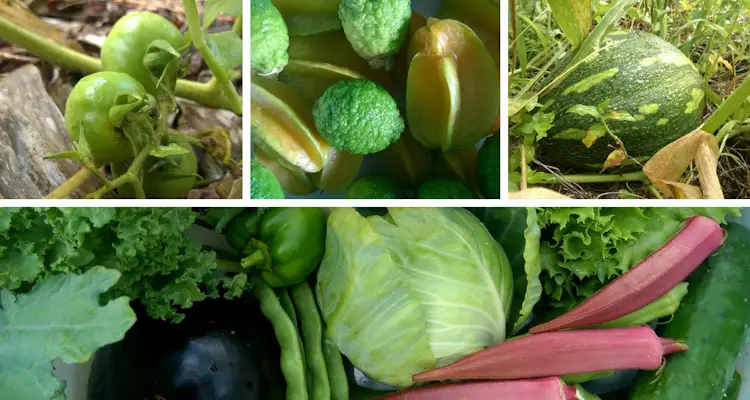
To do this, we plan Syntropic systems based on the plants’ phase of succession and light requirements. The terms for these are Succession Cycle (Sucession) and Stratification Level (Stratum) .
The Succession Cycle is divided into three main stages.
- The Placenta is the early stage, characterized by vigorous vegetative growth and short life spans.
- The Secondary stage is characterized by taller shrub-like trees that can live for many years.
- The Climax is the mature stage, characterized by fully developed fruiting and lumber trees that can last indefinitely.
It is common for these to be further divided based on the system. E.g. Placenta 1, Placenta 2, Secondary 1, Secondary 2, etc.
Note: One succession cycle can last for hundreds of years or until there is some form of disturbance to the system, such as a storm or fire. These disturbances reset the cycle and simultaneously advance the evolution of the entire system.
The Stratification Level, or Stratum for short, refers to the light requirements of various plants. It is divided into 4 levels.
- Emergent
- High
- Medium
- Low
As the names suggest, in most cases, a plant’s height gives an idea of its Stratum, within a succession stage.
In planning a Syntropic System, we use these two factors to choose the various plants in the group or consortium.
Here is an example of a simple syntropic consortium.
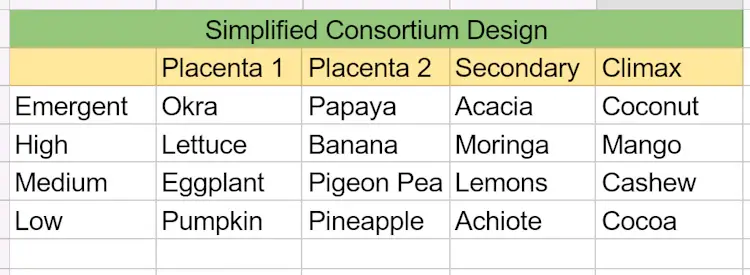
Note: Certain plants can occupy a different stratum in the consortium, based on the stage of succession and other plants within the group.
3. Synchronized Pruning To Stimulate Growth
This Syntropic principle relies on understanding the plant’s life cycle and its effect on soil organisms and neighboring plants.
You might have noticed that plants thrive in their early stages of growth. They start to slow down as flower buds appear. While fruiting, most plants begin to look miserable and die shortly afterward, in the case of annual plants.
Note: The stage at which the plant starts to slow down and decay is called senescence.
While this is happening above ground, microorganisms within the soil continuously communicate with the plants via their roots and provide plants with nutrients they need in exchange for sugars.
The plant’s nutrient requirements will vary based on its life cycle stage.
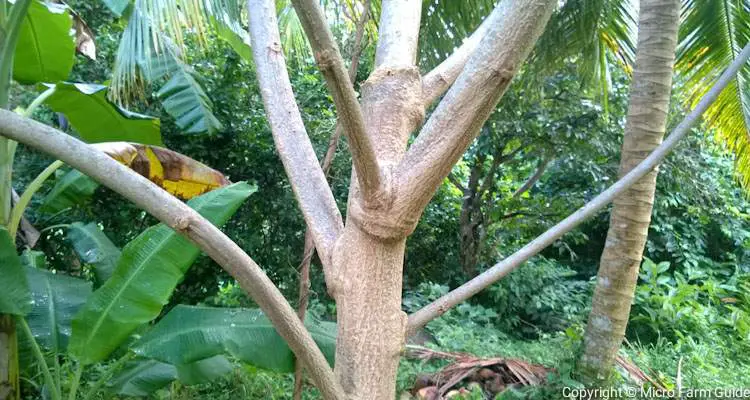
Syntropic Farming seeks to interrupt the cycle before the plants produce flowers, encouraging vegetative growth.
When done simultaneously throughout the system, this interruption stimulates organisms in the soil to provide nutrients required for the rapid growth of the plant and its neighbors.
Unfortunately, the opposite is also true. If many plants can reach senescence, this will encourage the entire system to slow down.
Note: In Syntropic Farming, specific plants are used to do this. They are referred to as biomass plants or trees. Target fruit trees are allowed to produce fruit and pruned after the harvest.
Is Syntropic Farming Only For Tropical Regions?
One common misconception about Syntropic Farming is that it can only be done in Tropical regions.
This is due in part to the following:
- The fact that the name contains the word “tropic.”
- Syntropic Agroforestry was developed in Brazil, and the original project mimics a rainforest.
- Most of the promoters of the system demonstrate it within tropical regions.
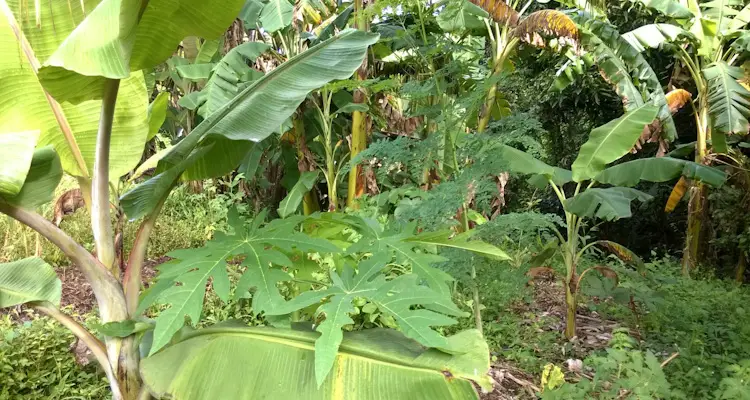
However, Mr. Götsch emphasizes that Syntropic Agroforestry can be adapted to just about any region through knowledge and observation of its set up area.
Note: Each Syntropic system is unique to the location in which it is set up. While the principles remain constant, certain factors such as terrain, weather, and other resources will influence the selection of plants, design, and scale.
Can Syntropic Farming Be Scaled Up or Mechanized?
Syntropic Farming is scalable, as is evident by Mr. Götsch’s original 1200 acre system in Brazil, which has evolved into a thriving, productive rainforest.
Mr. Götsch also created numerous other commercial systems and specialized tools to rival conventional methods.
Even with these advancements, he admits that the installation and management of Syntropic Agroforestry systems are labor-intensive.
However, it does not require external inputs such as chemical fertilizers and pesticides, resulting in additional ecological benefits.
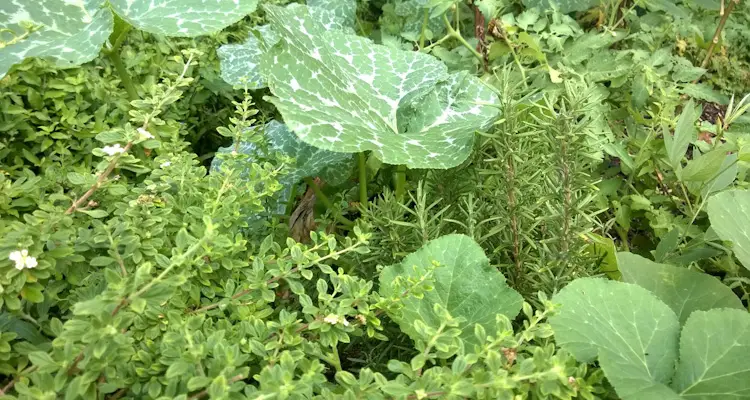
The yield from the system usually equates to and often surpasses that of the conventional counterpart. The other plants grown within the systems result in additional income for the farmer, covering the labor cost.
While scaling and machinery are possible, Syntropic Farming presents the most opportunity for smallholding farmers. Especially those who operate in less than ideal conditions, such as rugged terrains and limited resources.
Note: Initially, a Syntropic System requires a source of water during dry spells. Some practitioners also draw from other techniques, such as JADAM Organic Farming, to introduce microorganisms to their Syntropic system.
What Is The Difference Between Syntropic Farming and Permaculture?
The main difference between Syntropic Farming and Permaculture is their scope of focus.
- Permaculture encompasses a wide range of topics. It deals with ethics, morals, and other factors that influence the development of a more sustainable society.
- Syntropic Farming deals with the hands-on creation of an Agroforestry system that mimics nature to produce food while restoring depleted soils and ecosystems.
While Syntropic Agroforestry was not developed under Permaculture, their principles align closely.
Incidentally, some practitioners of Permaculture promote Syntropic Farming as a more practical approach to market gardening and food forest creation.
You can read 10 Differences Between Syntropic Farming And Permaculture for more in depth details.
How To Get Started With Syntropic Farming
According to Mr. Götsch, knowledge is the most essential factor to success in Syntropic Farming. Unfortunately, for years, this was available mainly in Portuguese.
Thankfully, you can now find many videos by enthusiasts and seasoned practitioners alike.
However, the Syntropic Farming Guidebook is one of the most valuable documents I’ve found, available free as a PDF download.
Alternatively, there are multiple courses available online. However, remember that Syntropic Farming is hands-on practice. If you choose to go that route, ensure it is practical.
Note: You can find links to the guidebook and other resources in the reference section below.
Final Thoughts
Syntropic Farming has transformed how we approach organic food production on our farms.
Its principles are simple to learn and implement, even in regions where resources are limited.
While Syntropic Farming is labor-intensive, the system creates a favorable working environment, becoming more productive over time.
Related Questions
What Is Agroforestry?
Agroforestry is the intentional growing of various trees and other agricultural crops on the same plot of land. The arrangement and types of vegetation grown are dependent on the farmer’s desired outcome.
What Are Biomass Trees?
Biomass trees are plants grown within an Agroforestry system as a source of organic matter. In most cases, these trees are fast-growing operant to repeated pruning. E.g. Eucalyptus, Gliricidia, Leucaena, and Bananas.
What Is A Consortium In Syntropic Farming?
A Consortium refers to a grouping of plants containing a diverse assortment, from grasses to trees, with different heights, needs, and life expectancies.
References
Agenda Götsch. What Is Syntropic Farming? agendagotsch.com. Accessed January 2022
Global Freedom Project. Syntropic Farming Guidebooks. global-freedom-project.org. Accessed January 2022
Adam Nz. Syntropic Agroforestry Resources. adam.nz. Accessed January 2022
